The cockatiel, or weiro as it is generally known in WA, is a semi-arid bird species that is found in many parts of Australia. Males and females both make great pets, and they’re fairly easy to keep.
Interestingly, the cockatiel is one of the only species where male birds will often mimic or whistle more than female birds. There are many different colour mutations of the cockatiel, including the popular pearl and lutino varieties.
Cockatiels generally do well with cage mates as they are often quite playful; however, it is important to introduce any new cage mates slowly, as not all birds will get along well.
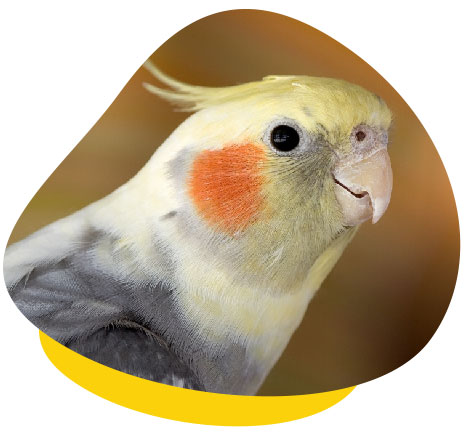
Diet and Nutrition
It is best to avoid diets high in commercially produced bird seed, as they are often high in fat and low in many of the essential vitamins that weiros require. Feeding a high seed diet can increase the risk of obesity and other more serious problems, such as lipoma (lump) formation and cardiovascular disease.
Every cockatiel is different, so for your own tailored diet plan, please get in contact with us. Our general recommendations for your cockatiel’s diet are as follows:
- 30-50% premium commercial pelleted diet suitable for cockatiels. Feeding more than 50% pellets can lead to problems and is not recommended for most cockatiels.
- 20-35% vegetables (recommended vegetables include: capsicum, broccoli, chilli, corn, carrot, zucchini, squash, spinach, pumpkin, sweet potato, beans and peas), sprouted seed and native vegetation (most Australian blossoms and plants are okay to feed). Fresh native grass varieties that produce small seeds on their stems are great for foraging and are highly encouraged.
- 10-35% quality commercial seed mix.
- 5-10% fruits (i.e. melons, strawberries, banana, blueberries, grapes, peaches, pear, apple).
- 1-5% snacks for training and as treats (unsalted nuts such as; macadamia, cashew and walnut), pasta, eggs and brown rice.
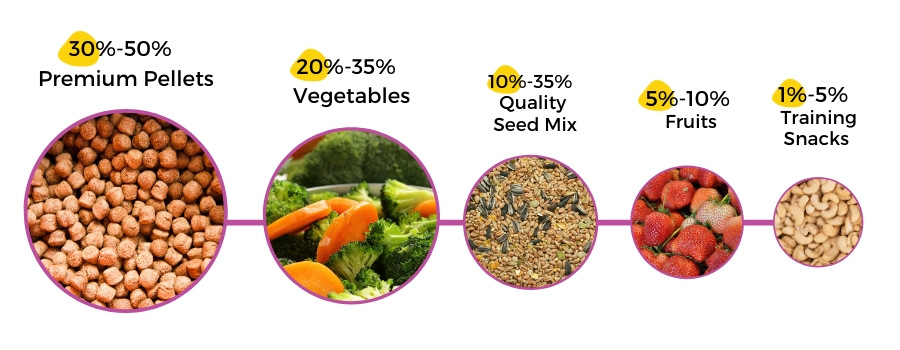
Housing and Enrichment
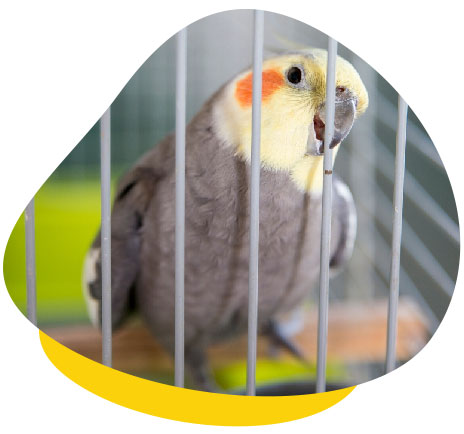
Cage
We advise a good quality powder coated or stainless steel cage of an appropriate size. Some painted cages can contain lead elements which can be toxic to your bird. Cages that have been galvanised with a zinc coating can also cause problems, so please take care when selecing a cage.
Feeding and Water Bowls
Stainless steel or ceramic bowls are generally recommended as these materials are not porous, making cleaning easier and more effective. Plastic bowls can become porous after a while and can cause problems if bacteria build up in these areas.
Perches
Perches of various sizes are important for exercise of the toes and feet health. They also help to promote the natural wear of their toenails. Natural perches from native trees are ideal as they generally vary in size anyway.
Enrichment
All bird species benefit from having environmental enrichment in their housing at home, and it’s highly recommended and encouraged. Cockatiels are intelligent, and providing mental stimulation will help keep them from turning into grumpy, destructive pets.
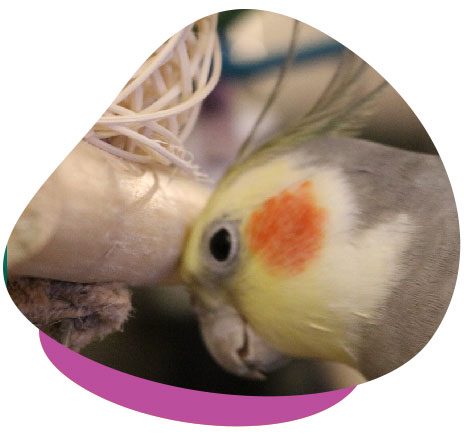
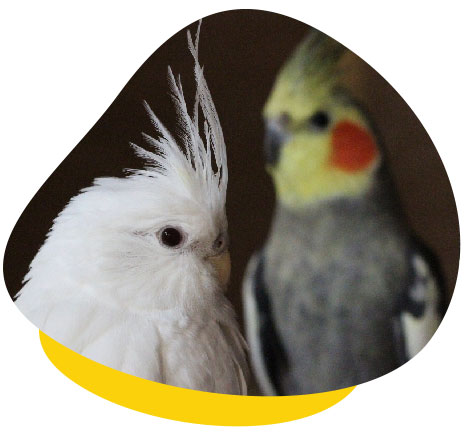
Cat balls with bells inside are great for throwing around and making noise. Simple things like utilising cardboard toilet rolls to hide food can provide hours of entertainment for many birds.
Cockatiels are generally very curious and sometimes get themselves into trouble with foreign objects. It is quite common for them to eat or chew on items that they shouldn’t (jewellery, plastic toys, rope toys, electrical cords, etc.). Please do not provide string or rope toys as they often will fray over time and can cause gastrointestinal obstruction if swallowed.
If you are concerned that your bird may have eaten or chewed on something that they shouldn’t have, then please get in touch with us.
Sleeping
It is important that your bird gets enough sleep, as long daylight exposure can stimulate excessive moulting and increased reproductive activity. We recommend you keep to the natural day length, except in cockatiels that are excessively reproductive.
If your bird is kept inside in a well-lit area, then you can cover the cage when the sun goes down and place them in a dark room to ensure that their day length is not too long.
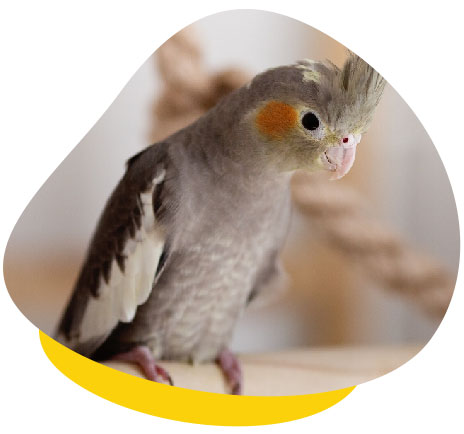
Common Diseases
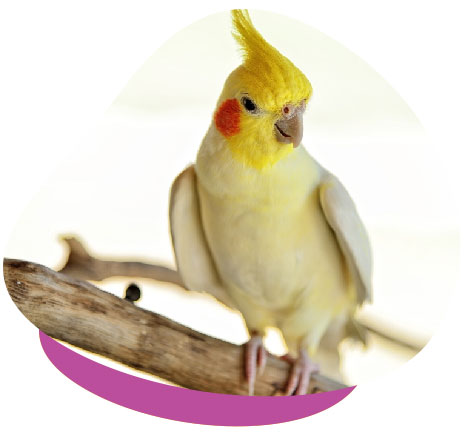
Gastrointestinal Disorders
One of the most common diseases that we see in cockatiels is an upset gastrointestinal tract. They will often present for regurgitation, vomiting or diarrhoea. If you see any of these signs, we recommend a consultation as there are many different causes and if left untreated you may be putting your bird’s life at risk.
Obesity
As mentioned above, obesity is a common problem in cockatiels. In many cases this is related to diets high in seed. Fatty lumps can develop and interfere with your bird’s movement. In many cases the size of the lump can be reduced by placing them on an appropriate diet. Sometimes these lumps can be more sinister and it is best to bring your bird in if you notice any lumps or swellings present.
Upper Respiratory Tract Infection
Upper respiratory tract infection is characterised by sneezing or ocular discharge and is common in young birds. Once again, it is highly recommended that they are assessed by an avian vet, as there is a range of different causes of upper respiratory tract disease.
Chlamydia infection is common in young birds, and this is a serious disease that can be transferred to other birds AND humans.
Kidney disease
Kidney disease can occur due to high protein or calcium diets. The disease requires medical attention and can be quite serious. Clinical signs associated with this disease include vomiting, lethargy and watery droppings.
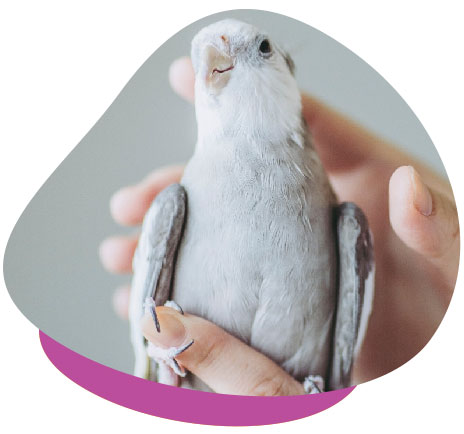
Veterinary Care
Regular check-ups every 6-12 months are important, as birds are very good at hiding any illnesses that they have. These check-ups allow problems to be detected early before they worsen.
Microchipping is also highly recommended as we see many birds that escape each year. Microchipping allows your contact details to be easily found if your bird is handed into any veterinary clinic or good rescue facility.
The Unusual Pet Vets uses a specialised small microchip that is inserted into your bird’s pectoral muscle. This is a quick, simple procedure that can be performed in a consultation time slot.
If you have any further questions about your feathered friend, please don’t hesitate to contact us.

